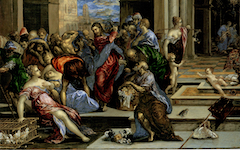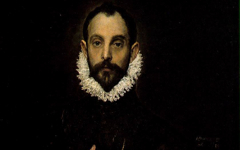El Greco’s Saint Veronica (c.1580)

El Greco, St. Veronica (c.1580) Oil on canvas. Museo de Santa Cruz, Toledo, Spain.
Click image to enlarge.
El Greco's St. Veronica depicts the woman whose cloth Jesus wiped his face with on his way to crucifixion. When he returned it, his image appeared. The cloth was ever after known as the vera icon (true image) and, while significant for all artists, it may have been even more important to El Greco who trained as an icon painter. Regardless, in keeping with the tradition revealed here, El Greco depicts himself as a woman holding his/her "painting" of her/himself as a male Christ. Christ is the symbol of our true non-gendered humanity and, in looking inwards as esoteric Christians did, he saw himself as Christ. That is the meaning of every painter paints himself, an imaginative depiction of our divine essence because, in the Inner Tradition, God is inside us and everywhere else too.
Click next thumbnail to continue

Top L: Detail of El Greco's St. Veronica (c.1580)
Top R: Detail of El Greco's Self-portrait (1604)
Bottom L & R: Diagrams in details of above.
Click image to enlarge.
Christ's face (left) is even based on El Greco's. Compared to a self-portrait from 25 years later, the resemblance is fairly obvious. Ignore his baldness, greater age and elongated egg-head and almost all else is similar. The eyebrows are less arched but that's about it. The ears, the shape of the nose and even the eyes are alike. Note how the one on the right in each head has a smaller opening then the other. In addition, they each have four strands to their beard, numbered for easier identification in the images below.
Click next thumbnail to continue

Diagram of a detail of El Greco's St. Veronica, turned 90* to the right, with a lower-case d in Greek script
Click image to enlarge.
Turn the beard to the left and it becomes even more significant as the longest strand appears in the form of a lower-case d in Greek script. El Greco's real name was Domenikos Theotocopoulos and he signed it in Greek too.
Click next thumbnail to continue

Diagram of a detail of El Greco's St. Veronica with an upper-case D in Greek script
Click image to enlarge.
The fold of the cloth on the left becomes, I believe, the partial form of an upper-case D. This seems to suggest that on one side he is an individual, domenikos, but on the other (the hidden side) he is the true perfection of humanity, the archetypal symbol of us all, Christ. Given the D's triangle he may be referring to the Trinity too.
Click next thumbnail to continue
In summary, El Greco represents himself as a female saint holding her imprinted cloth as an allegory of the artist with his art. In holding her image of the male Christ, Veronica conveys the androgyny of the artist's mind at the moment of creation. Christ's face, as El Greco's, tells in allegorical form how artists and like minds can perfect their own inner being and so purify themselves that they become at one with Christ. Here the Holy Face is El Greco's because he, El Greco, is working on the image. Perhaps this says not only that every painter paints himself but also that no-one else can purify your mind. No church nor priest. You must "paint" your own Self - and it takes imagination.
More Works by El Greco
Notes:
Original Publication Date on EPPH: 14 Nov 2013. © Simon Abrahams. Articles on this site are the copyright of Simon Abrahams. To use copyrighted material in print or other media for purposes beyond 'fair use', you must obtain permission from the copyright owner. Websites may link to this page without permission (please do) but may not reproduce the material on their own site without crediting Simon Abrahams and EPPH.


